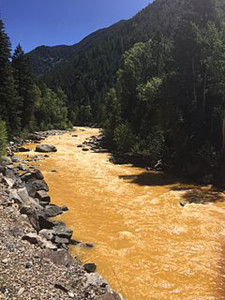By Denele Campbell
This past weekend I attended my 50-year class reunion.
While I was there, I visited the fabulous Coleman Theater, a restored 1930s opera house that graces the main street of Miami Oklahoma. The guided tour through its opulent staircases and gilded facades included a narrative about George Coleman himself.[fusion_builder_container hundred_percent=”yes” overflow=”visible”][fusion_builder_row][fusion_builder_column type=”1_1″ background_position=”left top” background_color=”” border_size=”” border_color=”” border_style=”solid” spacing=”yes” background_image=”” background_repeat=”no-repeat” padding=”” margin_top=”0px” margin_bottom=”0px” class=”” id=”” animation_type=”” animation_speed=”0.3″ animation_direction=”left” hide_on_mobile=”no” center_content=”no” min_height=”none”][1]
What lingered in my mind afterward and grows more prominent in my thoughts even now, is about how Mr. Coleman made his money.
You see, in 1904 that area of Northeast Oklahoma was found to harbor vast deposits of lead and zinc. During the years of production, Oklahoma mines produced 1.3 million tons of recoverable lead and 5.2 million tons of recoverable zinc.[2] The discovery of such potential wealth undoubtedly helped drive the state’s push for statehood in 1907.
This fabulous exploitation of natural resources supplied industrial processes which, for example, galvanized steel against corrosion. Zinc is also used to make die-cast alloys, brass and zinc oxides and chemicals.
Prior to the early 1900s, lead was used in the United States primarily in ammunition, burial vault liners, ceramic glazes, leaded glass and crystal, paints or other protective coatings, pewter, and water lines and pipes. The first and second world wars placed such demand on the mines that crews worked around the clock.
Automobiles boosted demand for lead not only for batteries but also as a fuel additive. Safely buried underground by Mother Nature, lead never goes away once mined and brought to the surface.[3]
George (and initially his brother Albert) made such a success of this mining operation that they earned a million dollars a week.
No wonder George could import African mahogany and commission a massive chandelier of Venetian glass, sparing no expense for a theater that would remind him of his summer home near Versailles. After Albert’s poor health forced his relocation to Colorado, George expanded his empire to build cattle ranches and finance local businesses.
Once the tour ended, I was like, wait a minute.
I asked a question of my friend who lives there. “How is it that George Coleman made all this money? What about the Native Americans who supposedly owned these lands?”
He laughed, “They got five percent. There were a few rich Quapaws.”
I’m still grappling with this.
While the Colemans and a few connected business associates raked in millions, the local landowners made a few thousand. Worse, 100 years later we see the real costs of this enterprise. Consider, for example, the nearby town of Picher, a ghost town now, formerly a major national center of lead and zinc mining at the heart of the Tri-State Mining District.
“More than a century of unrestricted subsurface excavation dangerously undermined most of Picher’s town buildings and left giant piles of toxic metal-contaminated mine tailings (known as chat) heaped throughout the area. The discovery of the cave-in risks, groundwater contamination, and health effects associated with the chat piles and subsurface shafts resulted in the site being included in 1980 in the Tar Creek Superfund Site by the US Environmental Protection Agency. The state collaborated on mitigation and remediation measures, but a 1996 study found that 34% of the children in Picher suffered from lead poisoning due to these environmental effects, which could result in lifelong neurological problems. Eventually the EPA and the state of Oklahoma agreed to a mandatory evacuation and buyout of the entire township.” ~ Wikipedia
Naturally it was the Quapaw and other Native American tribes who suffered permanent damage from this exposure as well as the loss of lands. Even as recently as my school years in that region, it was a regular entertainment to hang out at the chat piles where guys would show off their skill with cars and motorcycles, stirring up clouds of dust as they scaled the steep inclines.
So it’s not enough that the original inhabitants of this continent were forced away from their homes and hunting grounds as white settlers took over. The insult and injury only deepened as we first gave them new lands with the promise they could be assured of controlling it for the rest of time. Less than 80 years later, Boomers, Sooners, and other massive in-migrations of white ownership swept in and, as a bonus, left the tribes with irreversible damage to the land.
As a side note, this is similar to the standard practice of industry to locate their waste heaps and polluting processes in low-income and minority neighborhoods, both in the United States as well as Third World nations.
Which brings even more into focus the current stand-off in North Dakota over an oil pipeline.
According to an Associated Press report, “the $3.8 billion, 1,172-mile project would carry nearly a half-million barrels of crude oil daily from North Dakota’s oil fields through South Dakota and Iowa to an existing pipeline in Patoka, Illinois, where shippers can access Midwest and Gulf Coast markets. Announced in 2014, supporters said the pipeline would create more markets and reduce truck and oil train traffic—the latter of which has been a growing concern after a spate of fiery derailments of trains carrying North Dakota crude.
“The Standing Rock Sioux’s lawsuit challenges the U.S. Army Corps of Engineers’ decision to grant permits at more than 200 water crossings. Filed on behalf of the tribe by environmental group Earthjustice, the suit says the project violates several federal laws, including the National Historic Preservation Act, and will disturb sacred sites outside of the 2.3-million acre reservation. A separate lawsuit filed Thursday by the Yankton Sioux tribe in South Dakota challenges the same thing.” The lawsuit alleges that the pipeline, which would be placed less than a mile upstream of the tribe’s reservation, could impact drinking water for more than 8,000 tribal members and millions who rely on it downstream.[4]
Dallas-based Energy Transfer Partners, the owners of the project, says the pipeline includes safeguards such as leak detection equipment, and workers monitoring the pipeline remotely in Texas could close block valves on it within three minutes if a breach is detected.
Sounds good. Let’s ask the Quapaw how well those kinds of promises work out.
In a last ditch effort to stop the bulldozers, other Native American tribes and other supporters of the resistance have joined the Sioux in forming a human barrier to future work. Tribal leaders identified several sacred ceremonial sites and burial grounds which lie on private land in the path of the pipeline, citing these locations as even more reason to halt the project.
The day after tribal officials identified these sites and added them to their lawsuit, pipeline crews bulldozed through them—an allegation which Energy Transfer Partners denies.
This led to last Saturday’s clash between protesters and private security guards; law enforcement officials said four security guards and two guard dogs were injured, while a tribal spokesman said six people were bitten by the dogs and at least 30 people were pepper-sprayed.
There’s no end to the examples of white exploitation of resources discovered in supposedly guaranteed Indian lands. It’s an oft told tale of grab the money and run.  The 2014 spill of a gold mine tailings pond in Colorado provided colorful images of a golden-colored stream as the pollution entered the Animas River. Workers accidentally destroyed the plug holding water trapped inside the mine, overflowing the pond and spilling three million gallons of mine waste water and tailings, including heavy metals such as cadmium and lead, and other toxic elements including arsenic, beryllium, zinc, iron and copper.[5]
The 2014 spill of a gold mine tailings pond in Colorado provided colorful images of a golden-colored stream as the pollution entered the Animas River. Workers accidentally destroyed the plug holding water trapped inside the mine, overflowing the pond and spilling three million gallons of mine waste water and tailings, including heavy metals such as cadmium and lead, and other toxic elements including arsenic, beryllium, zinc, iron and copper.[5]
Downstream, the impact continues to be felt in three states—most particularly in the Navaho Nation where they suffered damage to their crops, home gardens and cattle herds. Arizona Senator John McCain has estimated that the tribe’s damages could exceed $335 million. So far, they’ve received $150,000.
Absurd that this kind of arrogance would occur time and time again. There is no excuse, no possible gain, that justifies more of the same.
While this oil pipeline in North Dakota is not planned to cross Sioux land, any leak will compromise their water supply. There is no such thing as a foolproof technology. Sooner or later, the pipeline will fail.
It’s not just the Sioux who are fighting this pipeline. White landowners have gone to court and mounted protests as well. Conveniently and not surprisingly, laws of eminent domain may apply, forcing landowners to accept the pipeline’s passage whether they want it or not.
As attorneys explained, “existing South Dakota law allows for pipelines holding themselves out as ‘common carriers’ engaged in the sale of commodities, like crude oil, to utilize public condemnation when necessary.”[6]
At least when George Coleman set about raping Northeast Oklahoma, the residents got a nice vaudeville theater out of the deal.
There is nothing anyone in the Dakotas or anywhere else in this pipeline’s route will gain other than a one-time payment for the easement rights.
Somewhere down the line, the oil will out.
Want to help? Visit the resistance website for more information. http://sacredstonecamp.org/
video via Democracy Now
[1] http://www.colemantheatre.org/opening-weekend
[2]https://www.ok.gov/mines/Minerals_Program/Mineral_Information_by_Type/Lead_and_Zinc/
[3] https://www.thenation.com/article/secret-history-lead/
[4] http://bigstory.ap.org/article/c0db8074f3464835ab90b0400afaee71/ap-explains-whats-dakota-access-oil-pipeline
[5] https://en.wikipedia.org/wiki/2015_Gold_King_Mine_waste_water_spill
[6] http://www.lexenergy.net/pipeline-easements-a-fair-deal/
Photos: (provided by author)
Editor: Dana Gornall[/fusion_builder_column][/fusion_builder_row][/fusion_builder_container]
Comments
- Environmental Poisons Hurting Our Nation’s Children—Especially Low Income Families - March 28, 2017
- Get Over It, Because Only Productive Dialogue Leads to Understanding - February 28, 2017
- Another War with the Indians. - September 12, 2016







